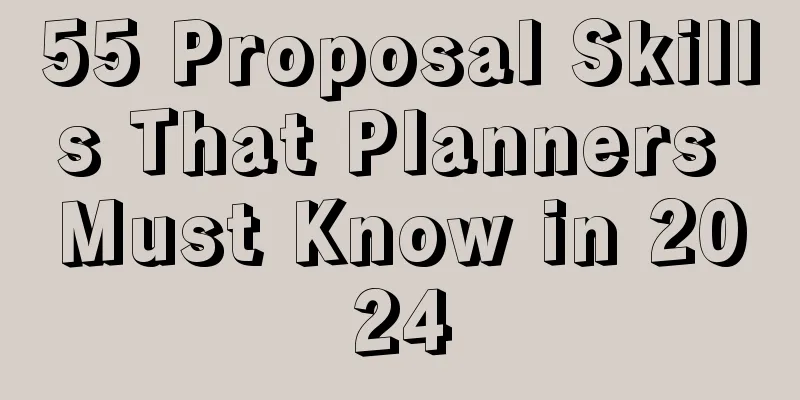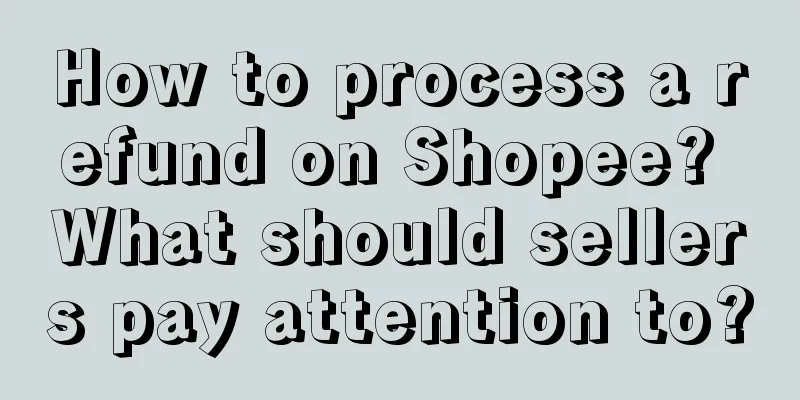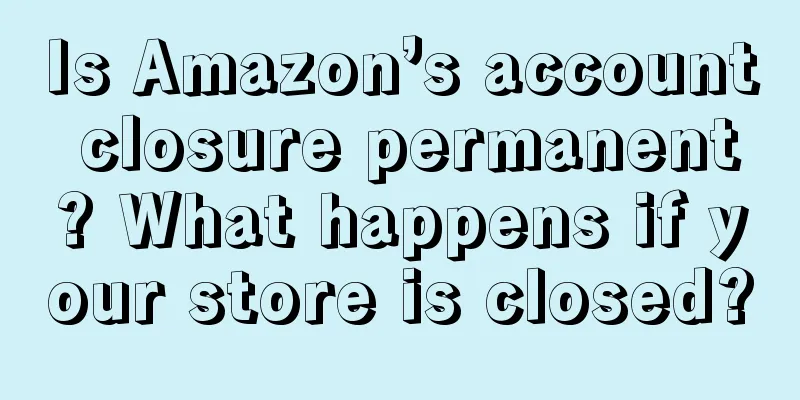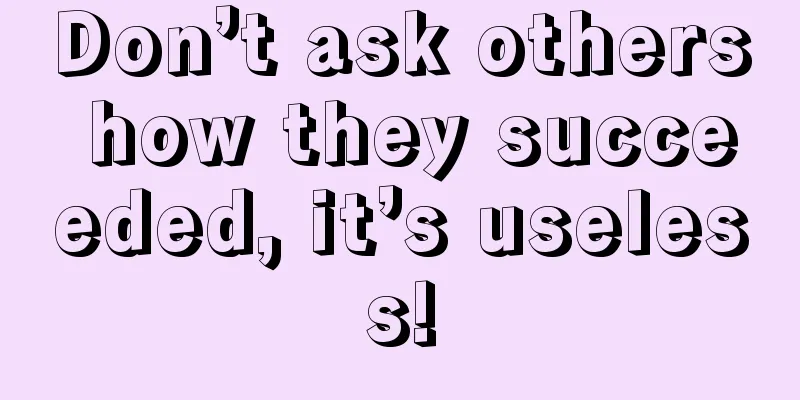55 Proposal Skills That Planners Must Know in 2024

A good strategy requires not only a skilled drafter but also a skilled proposer. A proposal cannot determine whether a bid is successful, but it can influence the outcome. The proposal reflects two aspects: good writing and good presentation. A good proposal helps, while a bad proposal hinders. In the past, I have experienced hundreds of proposals, big and small, in the process of Party B, Party A and my own entrepreneurship. I have stepped into pitfalls and gained benefits in the process. Next, I will share the 55 proposal notes I have compiled in the past, classified according to the five key words "understand, judge, find, want, and don't want", and I hope it will be inspiring to you. Proposals (externally to clients and internally to leaders) are a matter of personal opinion and there is no uniform standard. They are for reference only. 1. Understand1. Understand the companyEvery company has its own unique culture and its own way of doing things. Understand its past, present and future, know what it advocates and what it avoids, and know where to step on the pain points and avoid stepping on landmines. If the company is listed, you must read their financial reports, prospectus and related announcements. If it is not listed, you must review their past achievements and see how people in their company, peers and users evaluate them. 2. Understand the company’s productsThis is not only the bottom line, but also sincerity and professionalism. Use their products, benchmark their products, and then summarize their strengths and weaknesses. 3. Understand the industryWhat are the characteristics and barriers of this industry, on what basis are the players competing, what is the rationality of the existence of this industry, what are the substitutes, and what are the limitations of development. 4. Get to know the company’s founderEvery company is deeply imprinted with the mark of its founder, and this mark affects all employees from top to bottom. Get to know the boss of this company, read his external interviews, understand his internal speeches, ask his former colleagues, and sort out his past resume. 5. Understand the decision-makers and relevant influencers of the projectThe plan is decided by people, and it is related to people in addition to professionalism. Here we need to look at the key person who has the final decision-making power and the influencers whose opinions he consults. 6. Know your planYou must familiarize yourself with your proposal, whether it is written by you or not (because sometimes the proposal and the proposal are separated). Even if you wrote it, you still need to familiarize yourself with it after writing it, because many times, you forget a lot of things while writing, such as the general framework, the connection between each part, and the key points of each page. Only if you are familiar with the plan can you not be nervous, not get stuck, and not be considered unprofessional by the client. If you are not familiar with the plan, both the client and your boss will question your professionalism or attitude (thinking that you are perfunctory and insincere). 7. Know your opponentBefore writing a proposal, it is best to look into the competitors bidding at the same time as you to understand their strengths and weaknesses. What cards others might play and what our cards are. 2. Judgment8. Determine whether you are likely to be a bidderThere are two situations here. One is that the client has no intention to do it at all and just wants to deceive all the companies. Before you start bidding, you can ask people who have contact with them whether they have been put on the fraudulent manuscript blacklist. You can also ask friends who are or have worked in this company to see how this company usually operates. Another situation is that the client wants to do it, but has already made an internal decision. In order to make the process compliant, you are just a cannon fodder. At this time, you need to see if the client has a supplier that they have been cooperating with, why they want to compete this time, whether they may want to find a new supplier, or just symbolically look at the situation outside. You need to use various channels to see how far the relationship between the old Party B and Party A has developed. Do many people from this Party B jump to this Party A? Do they often hold workshops? 9. Judge your proposal attireDifferent industries have different requirements. The cosmetics industry generally requires girls to at least wear light makeup, and boys to dress a little more fashionably and appropriately, especially with makeup. In the maternal and infant industry, the makeup should not be too heavy, and the style and color of the clothes should not be too abrupt, so as to give people a gentle and comfortable feeling. Different types of companies are also different. For example, it is best to dress formally and simply in state-owned enterprises. 3. Find10. Find the winning pointBefore talking about the plan, you need to know clearly what the winning point of the plan is. Is the strategy accurate, is the creativity jumping, is the resource strong, is the execution stable, etc. Find the winning point, focus on it, and tell the customer what they want to hear. 11. Find the key pointsThe proposal has dozens or hundreds of pages. Which pages and sentences do you most want the other party to remember? You can talk about it or not. If you don’t want to talk about it, just focus on the important parts and put your time and energy on the most important areas. 12. Find a styleWhat style do you have? What style should this type of plan adopt? Only with style can it be remembered. 13. Find golden quotesAfter a proposal, it is impossible for the client to remember everything. Let the client remember what you want them to remember most and focus on the key points. 14. Find a temporary entry pointIf someone asks a question in the middle, it is also an opportunity. If you handle it well, it will be a plus. 4. Requirement15. Keep your energyRemember not to work overtime too late the night before the proposal. Stay in the best condition to make the proposal. Only when you have energy can you grasp the overall situation. Personally, I strongly advise against writing a proposal all night long. No matter what, you should sleep at least 5 hours the night before. Time pressure is a big problem, but it is definitely not the core issue. Most of the time, it’s because the rhythm is not well controlled, the internal thinking is not clear, and there are constant internal friction and changes, only to complete 80% of the plan in the first two days. 16. RehearseThe nervousness in making a proposal is mostly due to unfamiliarity. Even if the person making the proposal is very good, if he is not familiar with the plan, then "a good cook cannot cook without rice". 17. List questionsBefore making a proposal, you should make a list of client questions and how you will answer them. During the rehearsal, you need to define several roles: one is the client, one is the user, and one is yourself. You need to look at any questions from the perspectives of these parties. 18. Manage your timeGenerally, clients will set a time limit for proposals, so you need to consider both content and time and finish what you want to say within the specified time. 19. Speak with a sense of rhythmThe tone of voice should be ups and downs, that is, the tones should be high and low, and there should be pauses in the middle. Don't keep the tone too low and soft, or too high and harsh throughout. The ups and downs of voice are to distinguish the main and secondary and the key points, and it is also a manifestation of self-confidence. 20. Try to make more proposals while standingIf possible, try to make a proposal while standing up, because there are four benefits: Standing can focus everyone's attention on the speaker more than sitting; speaking can be more powerful; it is easier to make gestures and related actions to support proposals; and it is easier to observe the customer's temporary reactions. 21. The plan should be logicalThe solution is to discover problems, analyze problems, and solve problems (what methods to use and what logic of actions to use). Because of the differences in scenarios between writing and speaking, the logic needs to be fine-tuned according to the proposal scenario. 22. Try using a page-turning penIt is not convenient to turn pages when making a proposal while standing, and colleagues who help you turn pages sometimes do not understand your rhythm. Use your own page-turning pen and turn the pages whenever you want. 23. Strategy should have a sense of powerBe precise and don't be redundant. Use fewer adjectives, more nouns and verbs, and more short sentences. 24. Creativity should have a sense of conflictCreativity is the new combination of old elements, which means it should be unexpected and reasonable. 25. Creativity should be provocativeInsight into creativity and tell a provocative story. Try to be contagious, but don't be too exaggerated or deliberately performative. Don't ever speak awkwardly, it's easy to make the conversation boring. 26. Big ideas should be concrete actionsBig events require focus and doing something specific. 27. Company introduction is requiredMainly explain the company's positioning, related industries, related cases, and results achieved. It is best to be strongly related to this project and what problem can you solve. 28. Have an introduction to the teamBefore the show starts, an introduction must be made. Whoever does the introduction should talk about themselves first, then the key characters, and then the others. 29. There should be a self-introduction by the speakerBefore introducing your company, it is best to introduce yourself, explain your position and sell yourself in one sentence. 30. Bring business cardsAlthough paper business cards are used less frequently than before, it is better to be prepared. If a client wants to exchange business cards with you, it would be embarrassing if you don’t have one with you. In other words, sometimes the design style (material) of your business card, your position, and your name may all become a small microphone or highlight. 31. Look at people more and look at screens lessA proposal is a conversation and the screen is an aid, just like a conversation with someone. It’s not good if you always turn your back on everyone. Proposal is a two-way communication, which can be done through eye contact, conversation, and actions. If you keep looking at the screen, on the one hand, it means that you are not familiar with the case and can only make proposals through the screen. On the other hand, it means that you are not confident in your case and dare not look the client in the eye. 32. Be confidentYou must be confident, but not bluffing. You must have a moderate aura. If you yourself are not confident, how can customers trust you? Many times, customers are unsure, and when the plans are similar, aura can also be a help. 33. Keep your cell phone on silent modeIn addition to being a basic courtesy, it is also to prevent the sudden ringing of the mobile phone from disrupting the rhythm of one's proposal. 34. Have someone take meeting minutesWhen someone speaks, someone should take notes. Remember the key points, not everything. At the same time, observe the feedback of various client roles on the plan. 35. Post-meeting feedback emailIf there is another opportunity to make a proposal, remember to email the client for feedback after submitting the proposal, unify the consensus reached at the meeting, and then start making adjustments. 36. Data reports should have sourcesNo matter what data you find, you must know its source. Otherwise, how can you answer the question you might ask, "Where did this data come from?" 37. Everyone should take their seats properly.Generally, people sit opposite each other according to their job level, which is convenient for people at the same level to respond to each other. If there are more people, the C position in the middle is reserved for the person with the highest level, so that the boss of the other party knows who is in charge of your work, instead of letting him look around with his eyes. 38. Decide who will bring the proposalThe person who makes the proposal on the spot, the person who writes the proposal (the two may overlap), the person who can hold the whole scene, and the person who understands the implementation. 39. It is best to indicate the copyright on the last pageIn order to prevent clients from stealing proposals and writing fraudulent manuscripts to a certain extent, you can mark at the end, "We reserve the right to take legal action against any unauthorized copying or misappropriation of proposals and ideas." 40. Try a cup of coffee before making a proposalCoffee can instantly refresh and excite people, and coupled with psychological suggestion, it will help people get in the mood quickly. Everyone’s situation is different, and you can also use other methods to quickly improve your mental state. 41. Choose at least one campaign to discuss in detail in the annual case.If it is a full-year plan, it is impossible to talk about multiple campaigns in detail, so you only need to talk about 1-2 in detail. 42. If the front is stuck, someone needs to take over from behindIf the proposer gets stuck, remember to continue the conversation to avoid a dull moment. If the person in charge of the proposal notices that the proposer has gone off track or is being long-winded, he or she should continue the conversation appropriately to smooth things over. 43. The executive team must be fully equippedThe personnel serving to execute this project must be complete and have experience in this industry/project type, so that customers can feel at ease in handing the case to you. 44. Write the proposal in the form of a proposalInterview > Phone > Email. If possible, try to get an interview. The solutions for interview and phone are based on speech logic, and the solution for email is based on reading logic. 45. A big boss is needed to keep the peaceIt is best to have a big shot to support the question-and-answer session. If the proposal is good, it can add icing on the cake; if the performance is poor, it can also be selected to help. 46. There must be an executor to make people feel reliableWe also need people who understand implementation to be present. If the customer asks about the strategy or creativity that the customer is paying for, you need to have a clear idea of it, rather than just giving a rough draft. Never let the speaker answer all the questions, as that will make the company look unprofessional. 47. In the proposal, the team plays a double roleThe people sitting at the bottom of the Party B should not stand idly by and act as if it does not concern them. They should always observe the words and actions of the proposer and the client and pay attention to the entire proposal dynamics. At the appropriate time, perform a double act with the proposer, and don't leave the person mentioned above alone to perform a solo. The team should communicate well before proposing a proposal, and perform a double act without making things worse and disrupting the proposer's rhythm. 48. The plan must withstand scrutinyThere should be reasoning and arguments, not just guesswork. 5. Don’t49. Don’t keep repeating your catchphraseAppropriate catchphrases are fine, but don't use them too often. The speaker may not mean anything, but the listener may take it seriously. Firstly, it will distract people and secondly, it may even make people feel annoyed, especially when they are not in a very good mood. For example, maybe, probably, perhaps, I think... These catchphrases are fine when speaking normally, but if you often use them in proposals, it will make you look unsure or too subjective. 50. Don’t read the PowerPointMemorize it in your mind, don't just recite it. Everyone knows the words above, so don't read them out loud. If there are parts that need to be highlighted, you can read them out loud. Reading them out loud either means that the writer is not familiar with the case and cannot pass his own test, or that the writer did not write it himself and did not do his homework, which means that he does not value the client. 51. Don’t speak too fastIf you speak without pause, the customer will not be able to keep up with your pace, and it will seem that you want to finish quickly and end as soon as possible. No matter how urgent it is, don't speak too fast. You can choose to talk about the key points, but don't let your rapid speaking speed make your brain unable to keep up, and don't let this rapid speaking speed make the customer look confused and nervous. 52. Don’t just write “Thanks” or “Thank you” at the end of your proposal.Try to make every page valuable, leave a little thought, and use one or two sentences to repeat the key points of your proposal, or even use a word to wish the customer well. 53. Don’t be overly enthusiasticYou can be polite and create an atmosphere, but don't be slick, as this will make customers feel that you have no ability, or that even if you have ability, you are frivolous and unreliable. 54. You can write a verbatim script, but don’t let it lead you by the nose.Some people are very nervous and worried about getting stuck, so they write thousands or tens of thousands of words. Once they really write, it is easy for them to read to the screen on the spot, and get stuck once they are interrupted. 55. Do not take screenshots of the data portion of the report.This can be seen at a glance. Although it does not affect the final result in terms of content, it will affect people's perception. Because direct screenshots may be blurry, may have watermarks, and may not match the main color of the plan. VI. ConclusionA proposal is the icing on the cake, it cannot provide timely help. It is a form of persuasion and an important way to build trust. When making a proposal, you should start from the end in mind and think from the perspective of your clients or boss to understand what they really care about. Author: Zang Feng Source: WeChat official account: "Strategist Cangfeng (ID: clrcf2020)" |
<<: Why do you always get dissed for your data analysis?
>>: Abandoning Arc'teryx, cycling clothing becomes the new favorite of the middle class?
Recommend
Is Wish children's clothing easy to sell? How can I make it sell well?
Every family is willing to spend money on their ch...
Tongyi Qianwen: Skipping the third subject, what does it have to do with AI e-commerce?
In 2023, AI big models have almost overturned our ...
With 63 million members, how does the leading tea brand develop its private domain?
As a well-known tea brand in China, Heytea has gro...
How long does it take to open a Lazada Super Alliance account? FAQ
As a cross-border e-commerce platform, Lazada'...
How to set up a payment account on Shopee? Which payment account should I choose?
Shopee platform is one of the better developed cro...
Can Chinese people still open stores on etsy? How can Chinese people register?
You can sell handmade products and original brands...
How does an Amazon store operate? Things to note when operating on Amazon
Amazon is a very hot e-commerce industry. Like Ali...
No new tricks in cherry blossom season marketing?
What new marketing methods and changes have emerge...
Discount stores, how deep is the water?
What is the core problem of the discount store ind...
After ordinary people make money, remember these 6 points!
In this article, the author shares six things that...
5A Model under New Marketing
In the current new marketing situation, we should ...
How long does it take for Amazon to withdraw cash? How much is the withdrawal fee?
When opening a store online, collecting payments h...
What is the overview of the Lazada platform? Which one is easier to do business with Lazada or Wish?
Now many merchants who want to engage in cross-bor...
Insight into the Beijing Auto Show: Attribution of Automotive Companies’ Marketing Effectiveness
This article discusses the social media marketing ...
Classical method of data analysis: structural analysis
Do you feel that the data we see every day is usel...









